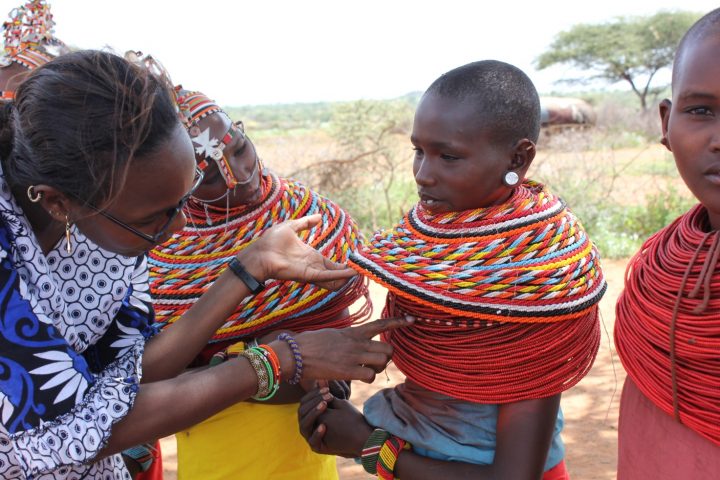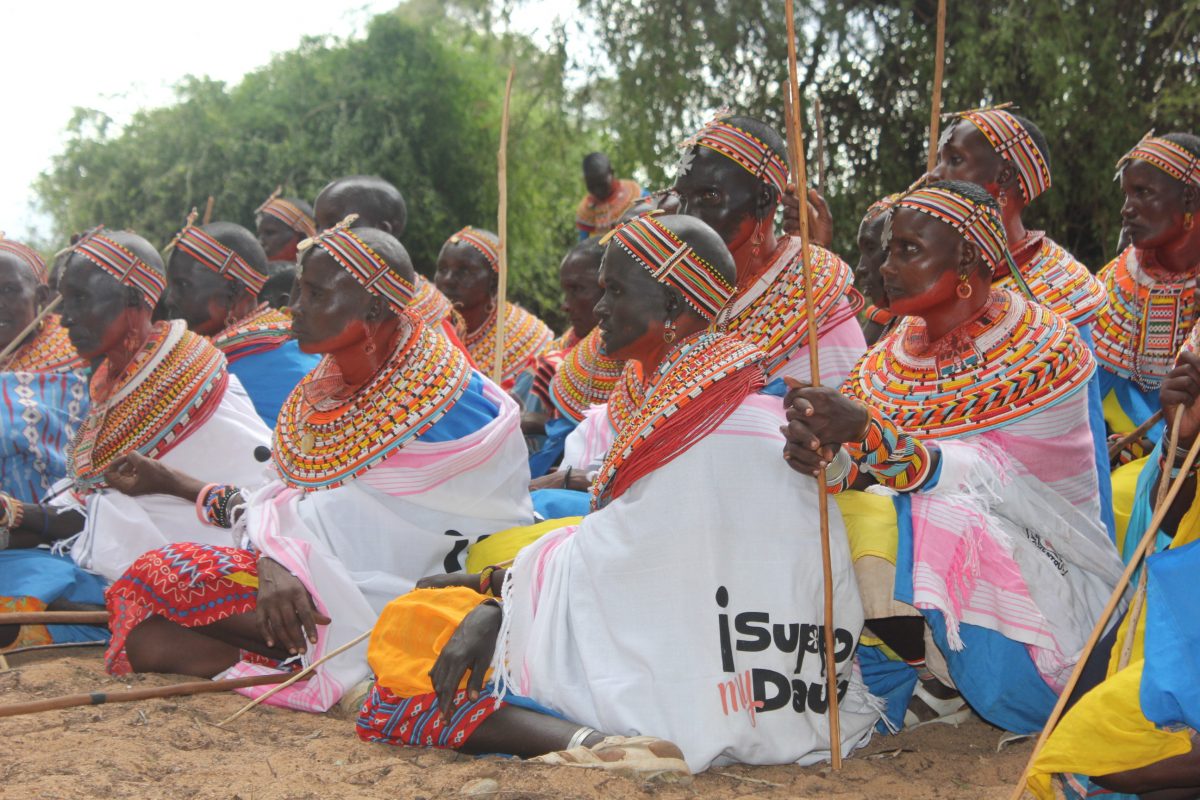Hidden tradition – girl child beading in Samburu communities

Jane Meriwas, ED of the Samburu Women Trust and a beaded girl (Photo: SWT)
Beading tradition, female genital mutilation and early marriages are intertwined in Samburu communities. KIOS partner organisation Samburu Women Trust (SWT) changes perceptions towards these harmful cultural practices in Kenya.
Campaigns against female genital mutilation (FGM) have been widespread in Kenya and around the world. There are various universal agreements on human rights, like The Convention on the Elimination of All Forms of Discrimination against Women (CEDAW), The Convention on the Rights of the Child (CRC) and The Maputo Protocol on Human and People’s Rights on the rights of Women in Africa, which forbid all forms of discrimination, violence and harmful cultural practices against women and girls. Also Sustainable Development Goals (SDGs) recognize gender equality as one of the goals and seek to universally eliminate all harmful cultural practices such as girl child beading, early forced marriages and female genital mutilation. However, beading as a harmful cultural practice has got far less attention due to its secrecy and being practised within one community only.
There are only few organisations working to prevent the practice of beading in Kenya. The practice was relatively unknown to the public in Kenya, until ”Silent Sacrifice” and “Beads of Bondage “ documentaries were made by Samburu Women Trust organisation. Furthermore, the national news in 2011 reported on forced abortions as a result of beading relationships among very young Samburu girls and Samburu warriors.
According to the beading tradition the warriors (Morans) are allowed to have a temporary marital relationship with a very young girl from the same clan as the warrior. The moran buys red beads for the girl after getting the mandate from the family of the girl. The main objective of the beading is to prepare the young girl for marriage in the future. Since the moran and his beaded girl are relatives, and the girl is uncircumcised, both marriage and pregnancy are forbidden. In case of a pregnancy, the pregnancy has to be terminated through cruel abortion by elderly women. If the beaded girl gives birth, the child has to be killed through herbs poisoning, since the child is perceived to be an outcast. The lucky babies who survive are given out to other communities like the Turkana tribe.
In addition to life threatening early pregnancies and abortions, the practice of beading exposes young girls to physical, mental and sexual violence. Most often the opinion of the girl does not matter, when the beading relationship is negotiated. There is no informed consent, but the negotiation is held between the warrior and the mother and brothers of the chosen girl. If the mother approves her girl to be beaded, she builds a hut (Singira) for her daughter and for the warrior. The warrior gives special beads composed of black and white to the girl as a commencement for a sexual relationship. These special beads signify that the girl is taken, and no one else can have an intimate relationship with her apart from her suitor.
Colourful beads are an important part of the Samburu culture, and they signify beauty and wealth for women and men. The patterns and colours of the beads have their own meanings: e.g Red signifies strength and power of the community, blue and green represent the natural vegetation (water and grass), which are vital for the livestock of the community, and black reminds of the hardships of the pastoralist lifestyle.

Members of Samburu community (Photo: SWT)
The Samburus are a nomadic pastoralist community living in northern parts of Kenya. They have treasured their culture and identity from pre-colonial times all the way to the modern days. Like most of the other indigenous communities, they are organised according to gender and age, which structures the division of labour in the communities. Samburu men are divided into children, warriors (Morans) and elders. Similarly, women are grouped into children, married women and elder women. The warriors protect the community and the livestock, and they are not eligible for marriage. The research by Samburu Women Trust discovers that the beading tradition was started so that the morans would not seduce the wives of the elders: the aim was to prevent conflicts between the men in the communities.
A group of young educated Samburu women founded Samburu Women Trust in 2009. The local organisation fights against the human rights violations towards Samburu women and girls, which origin from traditions and believes of the Samburu culture. The research by SWT found, that many of these harmful cultural practices are intertwined. Interviews done in Samburu community referred that families have started to circumcise girls even younger in order to prevent beading and unwanted pregnancies. However, the earlier young girls undergo FGM, the earlier they are eligible for marriage according to the Samburu culture. Most often beaded girls are between the age of 9 to 15 years.

Reuben Salimon Lemakima, the senior chief in Kipsing Location, Isiolo County, reading a Samburu Girl Child Magazine published by SWT (Photo: SWT)
Beading practice as well as female genital mutilation and early child marriages are against fundamental freedoms and human rights. Beading not only leads to physical and mental violence, but also leads to school drop outs for girls. The Constitution of Kenya protects the economic, social and cultural rights and also the right to education. Many Samburu people do not know that many of their cultural traditions towards women are harmful as well as human rights violations and also illegal according to the national law. Through education and advocacy work, Samburu Women Trust organisation has raised awareness of the illegality as well as harmful influences of the beading practice. With the funding from KIOS Foundation, SWT has done research, published and disseminated reports and materials as well as organised trainings for wide range of audience.
Even though advocavy work towards changing attitudes is challenging and slow, it is not impossible. According to SWT, their work has directly reached over 60,000 members of the Samburu communities including elders, morans, women, girls, opinion leaders and political leaders at the county and national level. As a result the taboo subjects like beading, forced abortions, infanticide, child marriage and FGM have entered into a public discourse among the communities. Furthermore SWT’s work to change community perception towards harmful practices has won huge support. The Executive Director of Samburu Women Trust, Ms. Jane Meriwas, who is a Samburu herself, tells that a very remarkable success has been the changeover among the ones who have been the strongest spokesmen for treasuring Samburu traditions: the elders. The elders have prohibited traditional huts (Singira), which were constructed to facilitate sexual contact between morans and the underage girls.
The Unspoken Vice in Samburu Community (2016)
Writer: Mira Ahlstedt
For more information contact KIOS expert Katja Ilppola, katja[at]kios.fi

The Finnish NGO Foundation for Human Rights strengthens the realization of human rights through support channelled to local civil societies in East Africa and South Asia. Currently KIOS supports 37 human rights projects in the regions. In 2016 KIOS supported altogether 56 human rights projects. In 2015, the number of supported projects was 79. The governmental cuts to overall development assistance in Finland have had an influence on the number of projects KIOS is able to continue to support. You can support our work for enhancing human rights at https://kios.fi/fi/lahjoita/.
